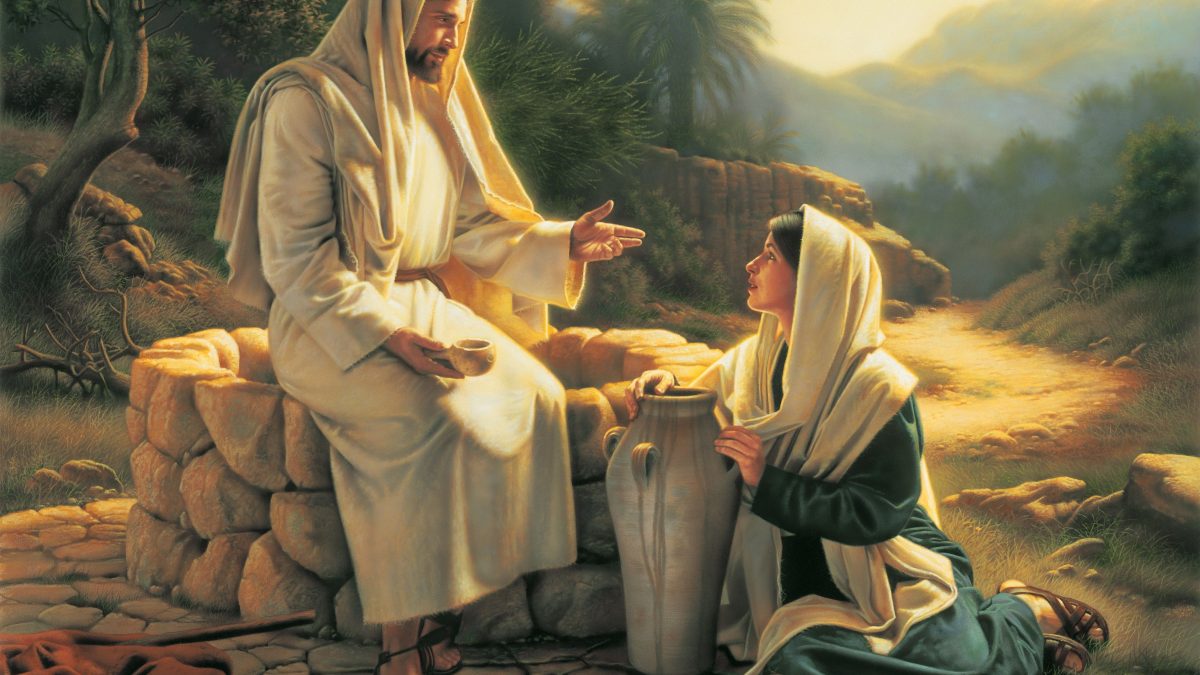
The Book of Revelation and Corona
July 16, 2020
The Kingdom of God and Kingdoms of the World
May 9, 2023A historical perspective on the Samaritan woman in John 4 by Alaa Qasasfa
Introduction
The story of the Samaritan Woman in John 4 is among one of the most prominent, well-known, and preached stories in the Gospels throughout the centuries. In this article, I select to focus and interpret verses 16-30 with a special emphasis on the expression “husbands”. The popularity of this story and the disputes among scholars on the expression “husbands” has generated numerous, abundant, and lengthy diverse interpretations. For instance, some theologians prefer to interpret the word “husbands” allegorically, presuming that the five husbands would represent the five false gods of the Samaritans as we read in 2 Kings 17:30.[1] Or perhaps, the five books of Moses.[2] Others view the overall aim of the plot pastorally as an example of how Jesus dealt with the Samaritan woman to lead her to believe in Him.[3] As a result of these different analysis, I intend in this paper to present a rational interpretation concerning the expression “husbands” and its connotations.
I propose that John frames the story of the Samaritan woman as a representation of a symbolic marriage between God and the Church. The hermeneutical tool that I would like to use to explore and reinforce this argument is based on a combination of several allusions between the story of the Samaritan woman and other stories in the New and Old Testaments, rhetorical emphasis of the narrator, and cultural-archaeological aspects. Before I start deconstructing the term “husbands” and its nuances, a summary of the story is needed.
A summary of the Story of the Samaritan Woman
In general, the Gospel of John was written to first century A.D. Jewish community to introduce Jesus’ identity and His ministry. However, in this story the audience was both Jewish (the disciples) and Samaritans. The plot tackles a deep meaningful conversation and debate between Jesus and the Samaritan woman in the city of Nablus in Palestine. The conversation took place around an ancient sacred well called Jacob’s Well.[4] Jesus was thirsty and stopped to drink water and met the Samaritan woman who came to draw water from that well. The woman was surprised that a Jewish man spoke to her and disregarded around five hundred years of an ancient enmity and hostility between the Samaritans and Jews.[5] The conversation was about water, living water, husbands, and the appropriate place of worship. Afterward, the Samaritan woman recognized Jesus as the Messiah and returned to her town to spread this news and invoke the men of the city who later invited Him to stay in their town. There are several missing pieces in the story, such as not knowing the precise identity of the Samaritan woman, as well as her role in the society. Also, there is a gloomy picture of the identity of her husbands, whether they are real or symbolic husbands. These missing pieces complicate the story and open it up for more assumptions, speculations, and opinions.
Exploring the expression “husbands” literally and metaphorically
When we read the story of the Samaritan woman, the first thing that would attract our attention after the theme of the living water is the expression “husbands”. Why did the Samaritan woman have five husbands? To answer this question properly, we should inquire, if the narrator is rendering these husbands factual or imaginary. When we examine the expression “husbands” based on the story’s original context, we end up toward the possibility that this expression could be both literal and metaphorical.
Firstly, if we assume that these husbands were literal, then there are affirmations and scenes from Jesus’ time, as well as from the intertestamental period, where women might have several literal husbands. For instance, women might experience the frequent death of their husbands, as we read in Mark 12:19-22, “Teacher, they said, Moses wrote for us that if a man’s brother dies and leaves a wife but no children, the man must marry the widow and raise up offspring for his brother. Now there were seven brothers. The first one married and died without leaving any children. The second one married the widow, but he also died, leaving no child. It was the same with the third. In fact, none of the seven left any children” (NIV). Furthermore, in the Apocryphal book of Tobit 3:8, we read another example where women could face or fall under demonic attacks; the book states that “Sarah had been married seven times, but the evil demon, Asmodeus, killed each husband before the marriage could be consummated. The servant woman said to Sarah, You husband killer! Look at you! You’ve already had seven husbands, but not one of them lived long enough to give you a son” (GNT). In this sense, the Samaritan woman may be caught in one of these difficult circumstances and this would justify her multiple husbands. However, the Talmud did not permit more than three marriages, including in the case of the death of the husbands.[6] This indicates that the narratives in Mark, Tobit, and in John 4 pertaining to numerous marriages may contain aspects of Hyperbole. Ska agrees, stating that there is “probably a willful exaggeration in the narrative [concerning the five husbands of the Samaritan woman].”[7] Regardless of the potential exaggeration, the Samaritan woman could have remarried frequently due to the death of her husbands which was beyond her control. From this standpoint, we should not rush to conclude and look down at her as a prostitute. Therefore, the preachers, pastors and ministers should pause their reckless treatment of accusing and rebuking her of being a prostitute. If she was a prostitute, then she should be stoned according to the Samaritan’s Pentateuch. When she returned to her town to spread the news about Jesus, the men of the city believed her; however, if she was an unacceptable woman in her community, then logically, these men would not listen to her. Additionally, the narrative of the plot refutes the idea of adultery as the rhetorical strategy of the gospel of John would not support this view. For instance, when Jesus encountered the woman who was caught in adultery in John 8, Jesus forgave and told her to not sin again.
Secondly, there are signs and hints in the original context asserting the symbolic approach of the expression “husbands”. In other words, the nuances of the term “husbands” could be a connotation for a metaphorical marriage as we will read below.
It was known that Samaria was a center of Baal’s worship because he was one of the most attractive gods in the ancient world due to his commission of being the god of storms, rain and fertility, which the land of Samaria was longing for. It is possible that the narrator of John 4 was playing with words because Baal has a double meaning as a master or husband. This approach is well established in the discourses of the book of Hosea, especially in chapter 2. The theme of this chapter and the narrative itself are about the relationship of marriage between the husband (most likely God), and the wife (most likely ancient Israel). In the discourse, Hosea was exercising wordplay on the word Baal as we read in Hosea 2:16, “On that day, says the Lord, you will call me, “My husband,” and no longer will you call me, “My Baal” (NRSV)”. From this perspective, if Baal is mentioned in the context of marriage as a husband, and Samaria was a center of worshiping Baal, then we should consider that the Samaritan woman was allegorically married to Baal or even to the five gods that the Assyrians brought to Samaria as we read in 2 Kings 17:30-34.
In almost every commentary on John 4, for example in Beutler’s commentary, the commentators would claim that there is inconsistency of logic and topic between verses 16-19. For instance, in verse 16, the dialogue was on the topic of “husbands” then immediately in verse 19 shifted to discuss the appropriate place of worship.[8] If we consider the approach that the woman might be a metaphorical representation of marriage to Baal, then there is consistency in the topic because Jesus and the woman would be continuing to argue about the aspect of religion, involving the metaphoric marriage, and the appropriate place of worship.
The idea of women marrying the gods is familiar in the Ancient Near East. Archaeologists have unearthed several archaeological archives in Babylonia discussing a group of women called ‘“Naditu” who metaphorically married to the gods in the ancient world. For example, we read intensively about the Naditu of god Marduk. [9] This idea sounds distant in time and geography from the story of the Samaritan woman; however, we should remember that the Jewish people were in captivity in Babylon and Assyria for at least seventy years. Hence, they may have been influenced by this ancient practice. Or maybe the narrator in our story signals or alludes to something associated with this practice which his audience should have known.
The rhetorical strategy of the book of John
The rhetorical emphasis of the narrator of the book of John would strengthen the element of metaphorical marriage. For instance, Jesus attended a wedding in John 2; this same chapter mentions the six jars that were full of water which would correspond to six o’clock which was the time when the Samaritan woman went to the well. In John 3, which immediately precedes the chapter of the story of the Samaritan woman, Jesus was described without any doubt as the bridegroom (John 3:27-30). In this light, I see chapters 2-4 alluding to the theme of metaphorical marriage.
Additionally, the story of the Samaritan woman as an allegory of marriage would go in harmony with the wider perspective of the Bible. The Old and New Testament emphasize metaphorically the idea that God is the groom and the people, or the Church is the bride as we clearly read in the book of Hosea, Song of Songs, the story of the ten virgins in Matthew 25, and the book of Revelation.
Summary
Based on the above, I lean toward the conclusion that the narrator of John 4 used the dreadful fortune of the Samaritan woman with her husbands as a teaching device to teach and allude that God is the appropriate, legitimate, forever, and metaphorical or spiritual husband or master for her and the Samaritan people – as a representation of the Church. In other words, the expression “husbands” was elaborated from literal to allegorical to teach a lesson. This is exactly like the theme of the water in the plot, the theme was developed and transformed from physical water to living or spiritual water. This transition from literal to metaphorical denotes double meanings or nuances of the themes. In this sense, we should consider that the expression “husbands” was elaborated and transformed from literal to metaphorical nuances to deliver the connotation of metaphorical spiritual marriage.
The application of the story
There are several theological lessons that we can learn and draw from the dialogue between Jesus and the Samaritan woman. First, the woman is not a prostitute as many commentators assumed as I demonstrated earlier in the article. Second, Jesus encompassed and included the Samaritan people in His grace and love regardless of their status of being despised and rejected. Third, the woman listened well to Jesus and even asked Him questions, and this was a path to her salvation. Four, we learn that the true worship is not tied or attached to sacred locations, but the genuine worship is by spirit and truth. Five, Jesus used a woman to be an instrument to give the good news to her people and community; I look at this aspect as an element of encouragement for women in Palestine, as well as in the Eastern cultures to strengthen their roles and voices in the churches and different ministries.
Bibliography
-
The Holy Bible, NIV, GNT and NRSV.
-
Arnold, Clinton. Zondervan Illustrated Bible Backgrounds Commentary. Michigan: Zondervan, 1984.
-
Bailey, Kenneth. Jesus through Middle Eastern Eyes. Illinois: InterVarsity press, 2008.
-
Beutler, Johannes. A Commentary on the Gospel of John. Michigan: William B.Eerdmans Publishing Company, 2013.
-
Borchert, Gerald. Dynamics of Evangelism. Texas: Word Books, 1976.
-
Cook, Joan. Wells, Women and Faith. (Article). Published in EGL & MWBS 17, 1997.
-
Hoskyns, Edwyn. The Fourth Gospel. London: Faber and Faber, 1947.
-
O’day, Gail and Hylen, Susan. John. Kentucky: Westminster John Knox Press, 2006.
-
Ska, Jean-Louis. Jesus and the Samaritan Woman (John 4) Using the Old Testament. Journal of Loyola School of Theology. Vol. 13, No.1 (1999).
-
Stol, Marten. Women in ancient near East. Berlin: Walter Gruyter, 2016.

 العربية
العربية


